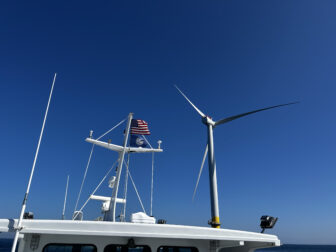For far too long, Baltimore has been forced to bear the burden of failed development that pollutes the city, causes disproportionate health impacts, and forces residents out of their communities. But now, offshore wind presents the city with an opportunity to become a manufacturing hub for clean energy.
South Baltimore is host to a slew of polluting and dangerous developments, including a 200-acre coal pier, medical waste incinerator, and numerous chemical and pesticide plants. It is also home to a crude oil shipping terminal. “Bomb trains” carrying explosive crude oil from North Dakota travel through the city, and many stop at the NuStar Energy Storage Terminal in Fairfield to transfer oil from rail to barge in order to ship it to refineries in the Northeast.
From 2013 to 2014, over 100 million gallons of crude oil were transported into Baltimore by rail to be offloaded and shipped to refineries. Transporting crude by rail puts 165,000 people in the “blast zone” in Baltimore – the area that could be directly impacted if a train were to derail and explode. Bakken crude oil is highly volatile and transporting it by rail has had devastating consequences, most notably the 2013 derailment and explosion in Lac-Mégantic, Quebec that killed 47 people and leveled the town.
There have been close calls in Baltimore in recent years. Last June, a train carrying acetone derailed in the Howard Street Tunnel right next to the Maryland Institute College of Art (MICA) — my alma mater. A school parking lot was filled with emergency vehicles for over a week while the derailment was contained. Last month, eight cars on a CSX freight train derailed on a sharp curve in Frederick County. While nothing spilled, the train was carrying hazardous materials and was traveling the same route that crude oil trains have been known to take to reach Baltimore.
And two weeks ago, a fire broke out in a scrap yard in Fairfield just across the street from the oil train shipping terminal there. The fire was contained, but once again, Baltimoreans were faced with a terrifying “what if” scenario had the fire reached the terminal.
These close calls, along with the string of derailments, fires, and explosions caused by oil trains across the country, demonstrate that transporting crude by rail is an unacceptable gamble that endangers people who live, work, and go to school near the tracks.
Meanwhile, it is clear that Marylanders are ready for clean energy.
Last month, the state held two public hearings in Berlin and Annapolis where residents showed up in droves to voice their support for offshore wind farm proposals.
Throughout the three-hour hearing in Berlin, person after person got up in front of the packed auditorium to speak about how offshore wind will help clean Maryland’s air, provide a reliable source of renewable energy, and create thousands of jobs across the state. Union members were a strong presence at the hearing, from piledrivers to carpenters, all of whom stand to benefit from the potential manufacturing and construction jobs across the state. And as a Baltimorean, talk of repurposing Sparrows Point into a wind turbine manufacturing hub was particularly exciting.
Instead of continuing to invest in failed development that brings polluting and dangerous materials like explosive crude oil into the heart of the city, Baltimore has an opportunity to become a central hub for clean energy jobs and fair development. Offshore wind offers one exciting pathway for a just transition in Baltimore where the city can move away from the polluting, dangerous fossil fuel industries of the past and become a clean energy powerhouse.
Tell the Public Service Commission to approve offshore wind in Maryland to help make this fair development future a reality in Baltimore.
Image at top from Sandia National Laboratories.






